- Sales SupportContact Sales
- Call us at: +(86) 15211074652
- Send us a email at: info@zr-fibercable.com
Optical cable terminal box features
Optical cable terminal box, also known as optical fiber terminal box, is a box for protecting the optical cable and pigtail fusion at the terminal of optical cable laying. It is mainly used for straight-through fusion of indoor and outdoor optical cables, branch connection and fixing of optical cable terminals, and plays a role in storage and protection of pigtails. The role of the connector.
Rack-type optical cable terminal box means that the optical cable terminal box is rack-mounted. The optical cable terminal box can be divided into wall-mounted (desktop-type), embedded, pull-out, rack-mounted and so on. The optical cable terminal box is a box that protects the optical cable and the pigtail fusion at the terminal of the optical cable laying.
Optical cable terminal box
The rack-mounted optical cable terminal box is generally installed with a standard network cabinet.

U is a unit that indicates the external size of the server, and is an abbreviation of unit. The detailed size is determined by the Electronic Industries Association (EIA), which is an industry group. The reason why the size of the server is specified is to keep the server at the appropriate size to be placed in an iron or aluminum rack. There are screw holes for fixing the server on the rack, so that it can be aligned with the screw holes of the server, and then fixed with screws to facilitate the space required for installing each server.
The specified size is the width (48.26cm=19 inches) and height (multiples of 4.445cm) inside the network cabinet. Because the width is 19 inches, a rack that meets this requirement is sometimes called a "19-inch rack." The basic unit of thickness is 4.445cm. 1U is 4.445cm, and 2U is 8.89cm twice that of 1U.
The size of the rack-mounted terminal box is generally 425mm, and it can be installed on the network cabinet with the addition of mounting ears.
As for the desktop optical cable terminal box, it can be placed on the desktop, the bottom of the cabinet or hung on the wall.
Another type is the pull-out optical fiber terminal box, which can protect the jumper from being broken. It is a bit similar to ODF, but it is much more convenient to enter and splice multiple optical cables than ODF.
The optical cable terminal box can be installed with FC\SC\ST\LC optical fiber adapters to be used in different occasions, and then connected to optical communication equipment through optical fiber jumpers. The box may not be important, but the pigtails and couplers must be equipped with carrier-grade products, otherwise the loss will be too large, which will affect the communication of the equipment.
These optical cable terminal boxes will eventually be spliced by optical fiber fusion splicing engineers. It is the last word to facilitate the construction of optical fiber fusion splicing engineers, and ensuring smooth communication is the quality assurance.
You might be interested in
We use cookies to ensure that we give you the best experience on our website. By clicking on "Accept" or continuing to use this site, you agree to our use of cookies in accordance with our Cookie Policy .You can refuse the use of cookies here.
Accept

